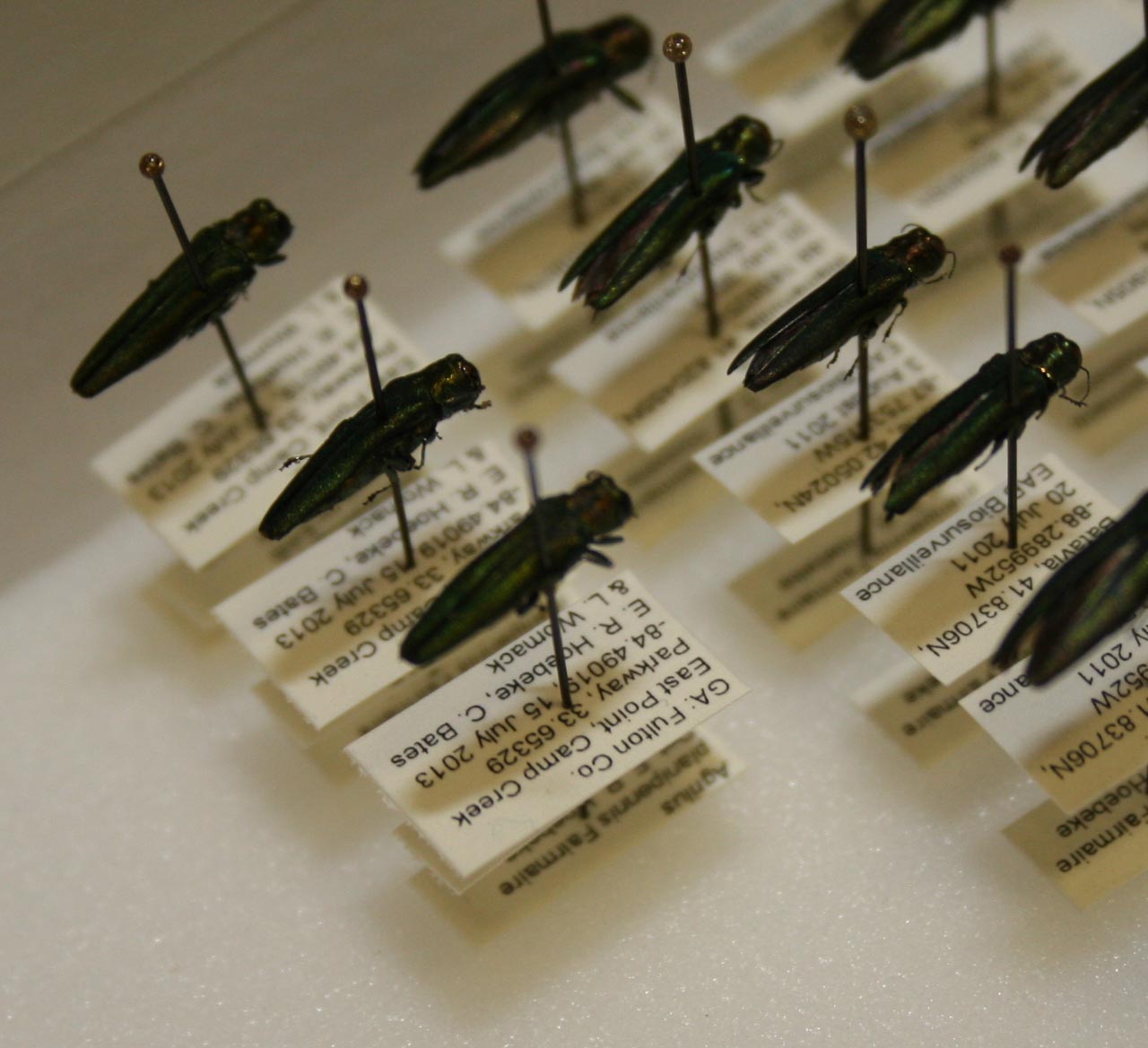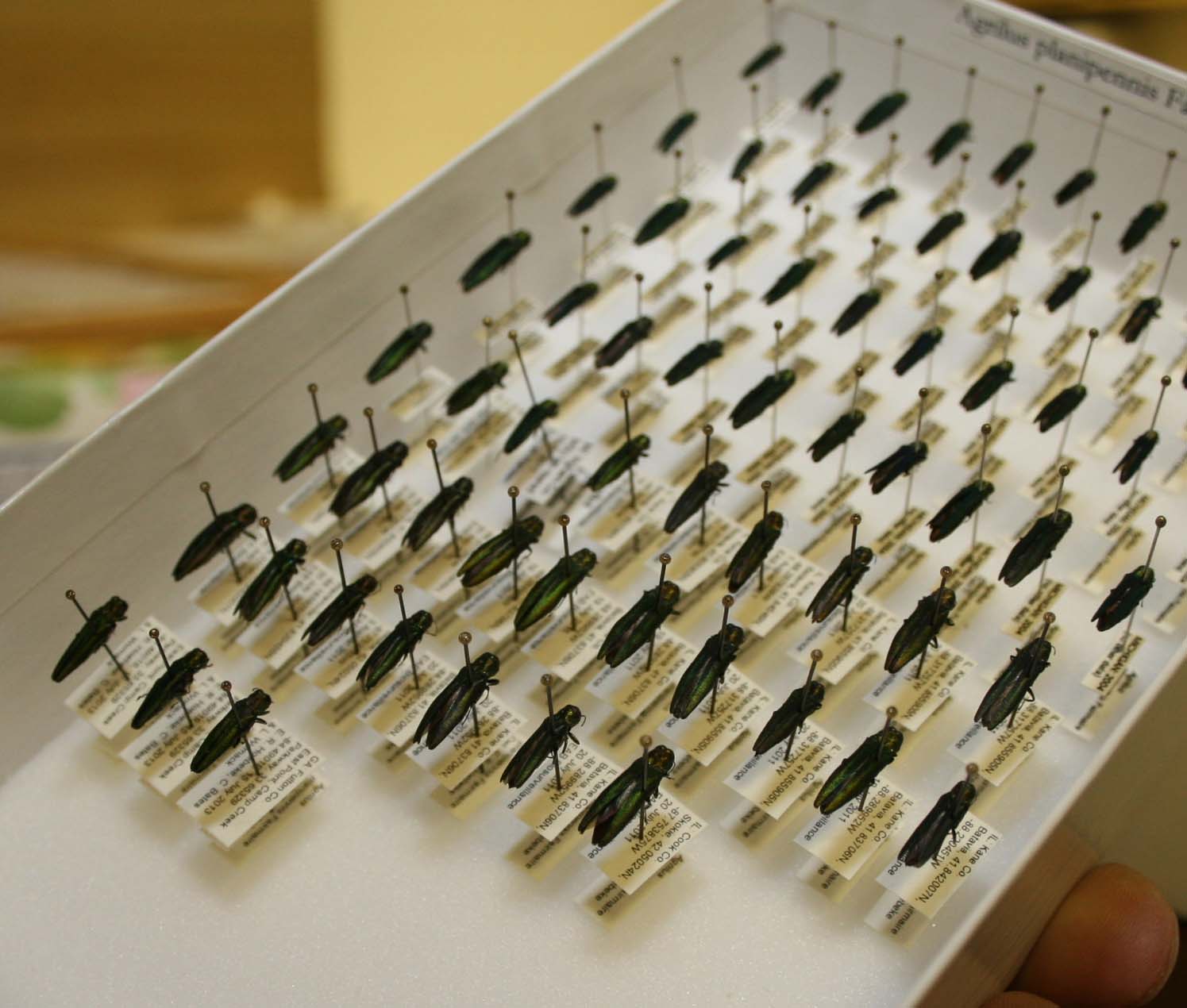For years foresters and invasive insect experts have been on the lookout for the arrival of an unwelcome guest in Georgia. Now that it’s here, they hope the public will help restrict its spread within Georgia.
The small, iridescent-green beetle has killed millions of ash trees across a wide swath of Canada and the upper Midwest since it was first detected in 2002. The emerald ash borer — Agrilus planipennis— has spread south and west from infested areas over the last decade.
In July, researchers found adult emerald ash borers in survey traps in DeKalb and Fulton counties. A follow-up ground survey found larvae in nearby ash trees, confirming an established emerald ash borer infestation.
Since 2005 University of Georgia invasive species experts have conducted an extensive trapping program in Georgia to screen for the emerald ash borer.
Georgia’s five species of native ash trees usually grow along stream banks. While ash only makes up about 1 percent of Georgia forests, they play an integral role in preventing the erosion of stream banks and keeping silt out of natural waterways. Ash is also a popular landscape tree, with 2.9 million trees planted around Georgia homes, businesses, parks and greenways. The value of these city trees in Georgia is estimated to be around $725 million.
Although the adult beetle is an active flyer, it is believed that the primary way the beetle spreads is by hitching a ride on infested ash firewood, logs and nursery stock. Emerald ash borer larvae kill ash trees by burrowing serpentine tunnels in the inner layers of bark, preventing the tree from transporting water and nutrients to and from the tree canopy.
The Georgia Invasive Species Task Force will launch a public outreach plan to try to curb the spread of this pest in the near future. This task force consists of the Georgia Department of Agriculture, the Georgia Forestry Commission, UGA, the Georgia Department of Natural Resources and the USDA Animal and Plant Health Inspection Service.
People can help slow the spread of this beetle through Georgia by not moving firewood and by helping others to understand how dangerous it can be to move firewood from one area to another.
“To prevent the spread of emerald ash borer, it is important not to move firewood in which the insect can hide,” said Kamal Gandhi, associate professor in the UGA Warnell School of Forestry and Natural Resources. “Buy local firewood, whether camping or for your home.”
To help reduce the spread of the emerald ash borer in Georgia, homeowners with ash trees should have a certified arborist check their trees for signs of emerald ash borer infestations.
Suspected infestations should be reported immediately so that foresters or arborists can understand how the infestation is spreading. This will aid in the development of effective methods to reduce its spread and impact.
“The faster (scientists) can track the spread of the insect, the faster they can work to stop it,” said Joe LaForest, integrated pest management and forest health coordinator at the UGA Center for Invasive Species and Ecosystem Health.
The public can report suspected infestations by:
- Using the SEEDN (Southeastern Early Detection Network) website www.eddmaps.org/southeast.
- Using the SEEDN Smartphone App [available for iPhone or Android devices] apps.bugwood.org/seedn.html .
- Emailing one of the Experts listed below; or by contacting a representative of the Georgia Forestry Commission, Georgia Department of Agriculture, the Department of Natural Resources or their local, UGA Cooperative Extension agent.
For more information about the emerald ash borer and how to protect ash trees, visit www.gainvasives.org/eab.
For more information about spotting signs of emerald ash borer infestations, view ww.youtube.com/watch?v=wXCynbvf4Lc#at=24.
UGA experts on the Emerald Ash Borer
- associate professor, Warnell School of Forestry and Natural Resources
- kjgandhi@uga.edu
- Gandhi studies the spread of invasive insects, including the emerald ash borer, and has been developing techniques to save infested trees and control ash borer populations.
Kamal Gandhi
- associate curator of arthropods, Georgia Museum of Natural History
- rhoebeke@uga.edu
- Hoebeke helped identify the first emerald ash borer specimens found in metro Atlanta. He started his entomology career in Upstate New York studying the emerald ash borer and has tracked it southward down the Eastern seaboard.
Rick Hoebeke
- co-director, Center for Invasive Species and Ecosystem Health, and professor of silviculture, Warnell School of Forestry and Natural Resources
- moorhead@uga.edu
- Moorhead develops and provides educational information and outreach programs on silviculture, forest regeneration, forest health and invasive species management.
David Moorhead
- integrated pest management and forest health coordinator, Center for Invasive Species and Ecosystem Health
- laforest@uga.edu
- LaForest develops protocols for identifying and mitigating harmful invasive pests in Georgia. He has helped develop apps and websites to educate the public about invasive species and streamline the invasive reporting process.
Joe LaForest
- co-director, Center for Invasive Species and Ecosystem Health, and professor of entomology, UGA College of Agricultural and Environmental Sciences
- kdouce@uga.edu.
- Douce develops and provides educational information and outreach programs on forest entomology, forest health, invasive species and regulatory program issues.
Keith Douce
- professor of entomology, UGA College of Agricultural and Environmental Sciences
- wghudson@uga.edu
- Hudson is responsible for educational programs covering management of insect pests of commercial and recreational turf, ornamental plant production, pecans, sod farms and Christmas trees.
Will Hudson





.png)


